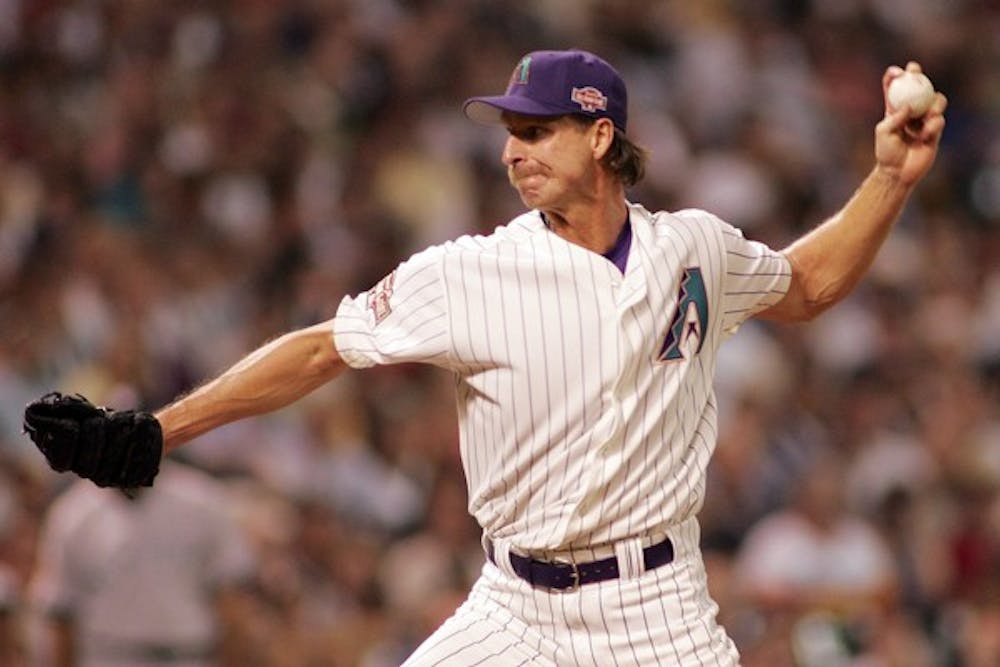 Randy Johnson of the Arizona Diamondbacks pitches in the top of the third inning for the National league at the 2004 Major League Baseball All-Star game on July 13, 2004, at Minute Maid Field in Houston. (Ron Jenkins/Fort Worth Star-Telegram/TNS)
Randy Johnson of the Arizona Diamondbacks pitches in the top of the third inning for the National league at the 2004 Major League Baseball All-Star game on July 13, 2004, at Minute Maid Field in Houston. (Ron Jenkins/Fort Worth Star-Telegram/TNS)I remember my first baseball memory. I was just 4 years old when it happened, but it is still crystal clear in my mind.
It was early November, and the game turned back from commercial to the voices of Joe Buck and Tim McCarver, who were on the call for the Fox broadcast. I had just finished dinner and sat watching the game, my attention fading in and out as any child's would.
The first picture I saw was an extremely tall man running in a funny-looking white and purple uniform with long-flowing hair that scared me to bits. In a world where I thought every adult was a giant, this man had taken it to another level.
"Don't worry honey, he's on our side," my mother told me as I watched in fear as the freakishly tall and slender man stood out on the mound.
That game was Game 7 of the 2001 World Series, with the hometown Arizona Diamondbacks hosting the New York Yankees. It was the eighth inning, with Arizona trailing 2-1.
The wiry figure with the mullet on my television was Randy Johnson, who would be named the National League Cy Young Award winner for the third-straight year after going 21-6 with a 2.49 ERA and a league-leading 372 strikeouts (the most since Nolan Ryan in 1974).
It was more than just his appearance that amazed me, however. His fastball was perhaps more intimidating than his stare down to home plate, as he regularly threw the ball in the upper-90s with accuracy and movement. Even the sound of the ball hitting catcher Damian Miller's mitt was different.
And this was after throwing 104 pitches the night before, a Game 6 masterpiece in which he gave up just two runs over seven innings to give Arizona new life in the series.
How I viewed baseball changed while watching "The Big Unit" pitch that Game 7. He was perfect in an inning and a third as the Diamondbacks completed the incredible comeback and World Series win.
At the end of that day it was Johnson, along with Game 7 starter Curt Schilling who were named World Series co-MVPs. In a season where Barry Bonds hit 73 home runs, the Seattle Mariners won 116 games and Mike Piazza helped post-9/11 America heal, they were the ones on top of the baseball world.
I would follow Johnson the rest of his career, including the ups and downs that followed. I watched on as he became the oldest pitcher in Major League Baseball history to throw a perfect game, doing so in the midst of a frustrating 2004 season. He went on to play in the pinstripes for the Yankees, drawing stark criticism despite solid play. He would return to the desert as a shell of his former self, battling through an injury-plagued tenure that robbed him of his trademark velocity.
But even in the twilight of his career Johnson still oozed greatness. He finally clinched his 300th career win in a San Francisco Giants uniform, reaching the pinnacle that pitchers work their entire careers to accomplish. He is still the most recent person to hit the 300-win plateau.
Johnson finished his career with the second-most strikeouts in Major League Baseball history (4,875), posting a record of 303-166 with a 3.29 ERA over 22 seasons.
But evaluating Johnson takes more than just numbers.
In his prime, there was no pitcher more intimidating than Johnson. Standing at 6 feet 10 inches tall with a mullet and a nasty fastball-slider combination, he was one-of-a-kind. He, like Ryan before him, took his lumps before ultimately honing his skills to be able to put his greatest weapon, his fastball, anywhere he wanted to put it.
Quite simply, I haven't seen a better major league pitcher in my lifetime, and I don't think Major League Baseball will see another Randy Johnson.
That's what the Hall of Fame is all about.
Reach the assistant sports editor at fardaya@asu.edu or follow @fardaya15 on Twitter.
Like State Press Sports on Facebook and follow @statepresssport on Twitter.




